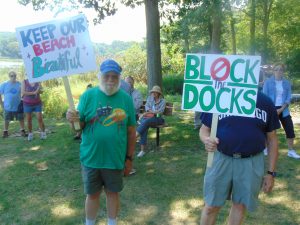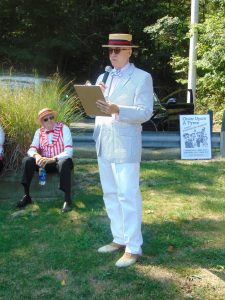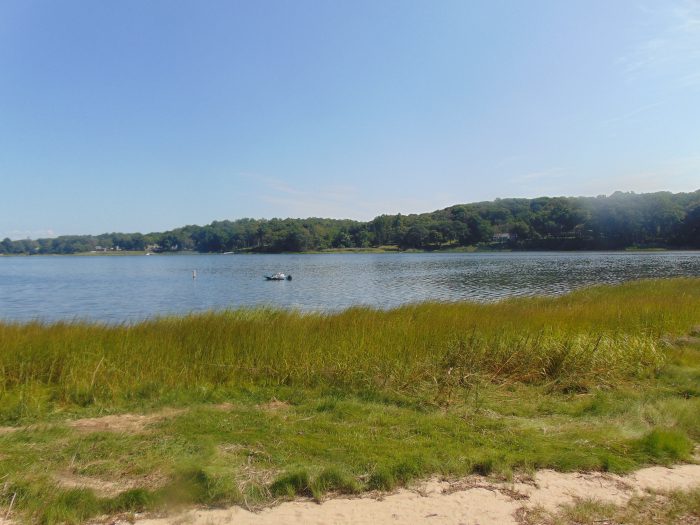Environmentalists, residents rally in Head of the Harbor to block private docks
A rally held at Head of the Harbor’s Cordwood Park Aug. 27 combined a bit of history, nature’s beauty and activism in one short hour.

The Rally to Block the Docks, organized by Head of the Harbor resident Lisa Davidson, attracted dozens of local residents, environmentalists and Stony Brook University students. Village residents have voiced concerns over the possible construction of a 186-foot dock on private property next to Cordwood Park and the potential of another 200-foot dock a few houses away. The footage includes a combination of permanent and floating docks. A Sept. 6 Village of Nissequogue Planning Board meeting currently has a vote scheduled regarding the 186-foot dock.
Protesters cited among their concerns the 186-foot spoiling the view of Stony Brook Harbor and restricting access to those walking along the beach or using their canoes and kayaks in the water. Many also feel it may encourage other homeowners to build similar private docks, leading to harbor pollution due to more or large boats.
“One property owner should not be allowed to ruin what is cherished and loved by an entire community,” Davidson said.
Among the speakers at the event were state Assemblyman Steve Englebright (D-Setauket); Kevin McAllister, founder and president of Defend H2O; John Turner, conservation chair of Four Harbors Audubon Society; and Head of the Harbor/Nissequogue historian Leighton Coleman.
Davidson is a member of the Joint Village Coastal Management Commission, a waterfront board of the villages of Head of the Harbor and Nissequogue. She said she recused herself from the commission on the matter of private docks.
“Because after seeing the numerous petitions we get for private docks, I realized that this beautiful bay is in grave danger if we as a community do not come together and take action now before it is too late,” she said.
She encouraged residents to reach out to the Town of Smithtown and New York State Department of Conservation, both of which approve first-phase private dock permits, to prevent future approvals. Davidson said homeowners might argue that they have riparian rights. She said those rights are satisfied when walking in the water or taking a kayak or canoe out on it, and do not include building docks.
Because the harbor is shallow, the dock must be meet DEC requirements that it stands in 3 1/2 feet of water even at low tide, hence the lengths of the proposed docks.
McAllister said, based on his experience, when one dock is built, there tends to be a push for more docks and bigger boats in the body of water, which he said leads to issues in the water such as prop dredging and salinity problems where the water is always cloudy.
Coleman said commerce once took place at the park, which had a negative impact on the harbor.

“We are now standing at the site of what was once an active boatbuilding yard and shipping port, where New York City’s manure was traded for cordwood to fuel the city’s numerous town houses,” the historian said.
He added, eventually, a boatyard’s use of arsenic to cure wood along with human and livestock waste runoff affected the harbor’s health. It was in the 1870s that Smith siblings, descendants of Smithtown’s founder, bought up large parcels of land. The harbor was then used for more leisurely activities, he said, until the 1920s brought to the area “commercial dredging for mining of sand and gravel, and the subdivision of the large estates into developments,” which threatened the waterway’s health once again. This led to the formation of incorporated villages, which in turn created zoning laws to protect the harbor and, in the 1940s, the Stony Brook Harbor Association was created.
“Sadly, the old guard has passed on, and we were left, apparently, with a false sense of security that our harbor’s healthy future was in safe hands, but thankfully as of today I see that we have a new generation of stewards stepping forth,” he said.
In the 1920s and ’30s, when there was dredging of the harbor as well as others on the North Shore, Englebright said, it was important that villages were formed to protect them. He called those who wanted to dredge the waters “essentially gangsters” who were “buying influence” with the towns, and “the towns were selling out the harbors.”
“That is the legacy of this village,” Englebright said. “That’s your birthright. That’s how you came into existence as a municipal jurisdiction in state law. There was no other way at the time to prevent the disposition of the permits by the towns.”
He added, “The Town of Smithtown has sold out the harbor bottom with approving the initial permit for a dock.”
Englebright said the body of water’s bottom is public property and “to give away public property is illegal.”
“It’s an echo of the outrage that led to the creation of these villages,” he said.
While waiting for the rally to begin, Turner said he saw a bald eagle, osprey, snowy egrets and more.
“Any time hiking the harbor, you know that the harbor, from an ecological and biological perspective, it’s just a really vibrant ecosystem,” he said.
Turner added there are several diamondback terrapins in the harbor, too. The DEC has listed the decrease in the animals a concern. They come ashore in June to lay their eggs, Turner said, and a dock could increase human traffic which in turn could have an adverse impact on the terrapins.
“We hope that the villages and the Town of Smithtown will not grant private access to a public trust resource that could ultimately have a really adverse impact upon the harbor,” he said.
Turner added he looked at the Suffolk County GIS viewer and counted approximately 54 properties around the harbor.
“If these are approved, what prevents those other 52 or 50 owners down the road from requesting permits to build docks — docks that are on the same scale as what these are,” he said.
To pay homage to the history of the location, rally organizers served ginger ale and root beer, and the Once Upon a Tyme Barbershop Quartet performed for the attendees at the beginning and end of the rally.
Davidson said she and others have been working on circulating a petition which they will present to the Nissequogue Planning Board on Sept. 6.







